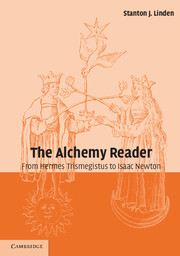Book contents
- Frontmatter
- Contents
- List of illustrations
- Acknowledgments
- List of abbreviations
- Illustrations
- Introduction
- Part I Ancient texts
- Part II Islamic and medieval texts
- 10 KHALID IBN YAZID (635-c. 704): From Secreta Alchymiœ
- 11 JABIR IBN HAYYAN (eighth century)/PSEUDO-GEBER (thirteenth century): From Of the Investigation or Search of Perfection; Of the Sum of Perfection; and His Book of Furnaces
- 12 AVICENNA (c. 980-1037) De Congelatione et Conglutinatione Lapidum
- 13 ALBERTUS MAGNUS (1193? or 1206?–1280): From the Libellus de Alchimia
- 14 ROGER BACON (c. 1219–c. 1292): From the Radix Mundi
- 15 NICOLAS FLAMEL (1330?–1417?): From His Exposition of the Hieroglyphical Figures
- 16 BERNARD, EARL OF TREVISAN (fl. late fourteenth century): A Treatise of the Philosopher's Stone
- 17 GEORGE RIPLEY (1415–1490): The Epistle of George Ripley written to King Edward IV
- Part III Renaissance and seventeenth-century texts
- Glossary
- Bibliography
- Index
15 - NICOLAS FLAMEL (1330?–1417?): From His Exposition of the Hieroglyphical Figures
Published online by Cambridge University Press: 05 October 2014
- Frontmatter
- Contents
- List of illustrations
- Acknowledgments
- List of abbreviations
- Illustrations
- Introduction
- Part I Ancient texts
- Part II Islamic and medieval texts
- 10 KHALID IBN YAZID (635-c. 704): From Secreta Alchymiœ
- 11 JABIR IBN HAYYAN (eighth century)/PSEUDO-GEBER (thirteenth century): From Of the Investigation or Search of Perfection; Of the Sum of Perfection; and His Book of Furnaces
- 12 AVICENNA (c. 980-1037) De Congelatione et Conglutinatione Lapidum
- 13 ALBERTUS MAGNUS (1193? or 1206?–1280): From the Libellus de Alchimia
- 14 ROGER BACON (c. 1219–c. 1292): From the Radix Mundi
- 15 NICOLAS FLAMEL (1330?–1417?): From His Exposition of the Hieroglyphical Figures
- 16 BERNARD, EARL OF TREVISAN (fl. late fourteenth century): A Treatise of the Philosopher's Stone
- 17 GEORGE RIPLEY (1415–1490): The Epistle of George Ripley written to King Edward IV
- Part III Renaissance and seventeenth-century texts
- Glossary
- Bibliography
- Index
Summary
Flamel's most recent editor, Laurinda Dixon, notes that the Exposition of the Hieroglyphical Figures (first French edition, 1612) “was destined to inspire debate and conjecture not only in its own century, but for three hundred years thereafter” (Introduction, Nicolas Flamel: His Exposition of the Hieroglyphicall Figures (1624), xiii). The controversy centers primarily on questions about Flamel's identity as alchemist and author: was he – along with his beloved wife and alchemical partner, Perrenelle – a real, fabulously successful medieval adept whose transmutations resulted in many charitable acts in Paris and Boulogne (as reported in the Introduction to the Exposition, precisely dated 1413), or was the “Flamel legend” a fiction created by the work's first publisher, P. Arnauld de la Chevalerie, in the early seventeenth century? Current scholarly opinion favors the latter view, while admitting the existence of a wealthy medieval Parisian named Nicolas Flamel, a scrivener by trade, whose tombstone is still to be seen along a stairway in Paris's Musée de Cluny. Indeed, no manuscript or printed text of the Exposition that dates from before the seventeenth century has been discovered.
Flamel's Exposition is an excellent example of the combining of visual and verbal mediums so characteristic of alchemical discourse before and after the invention of printing. Most of the work is, in fact, given over to explication of the painted figures that he commissioned for an arch in the churchyard of the Innocents in Paris (see Figure 14); these were no ordinary representations but imitations of the allegorical illustrations from the famous book of Abraham the Jew, that had served as Flamel's alchemical inspiration.
- Type
- Chapter
- Information
- The Alchemy ReaderFrom Hermes Trismegistus to Isaac Newton, pp. 123 - 135Publisher: Cambridge University PressPrint publication year: 2003

